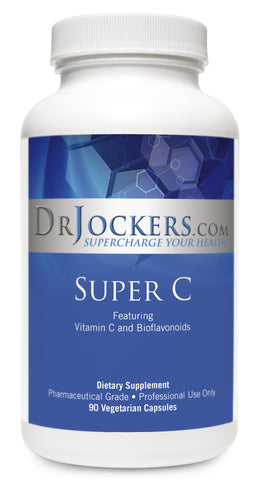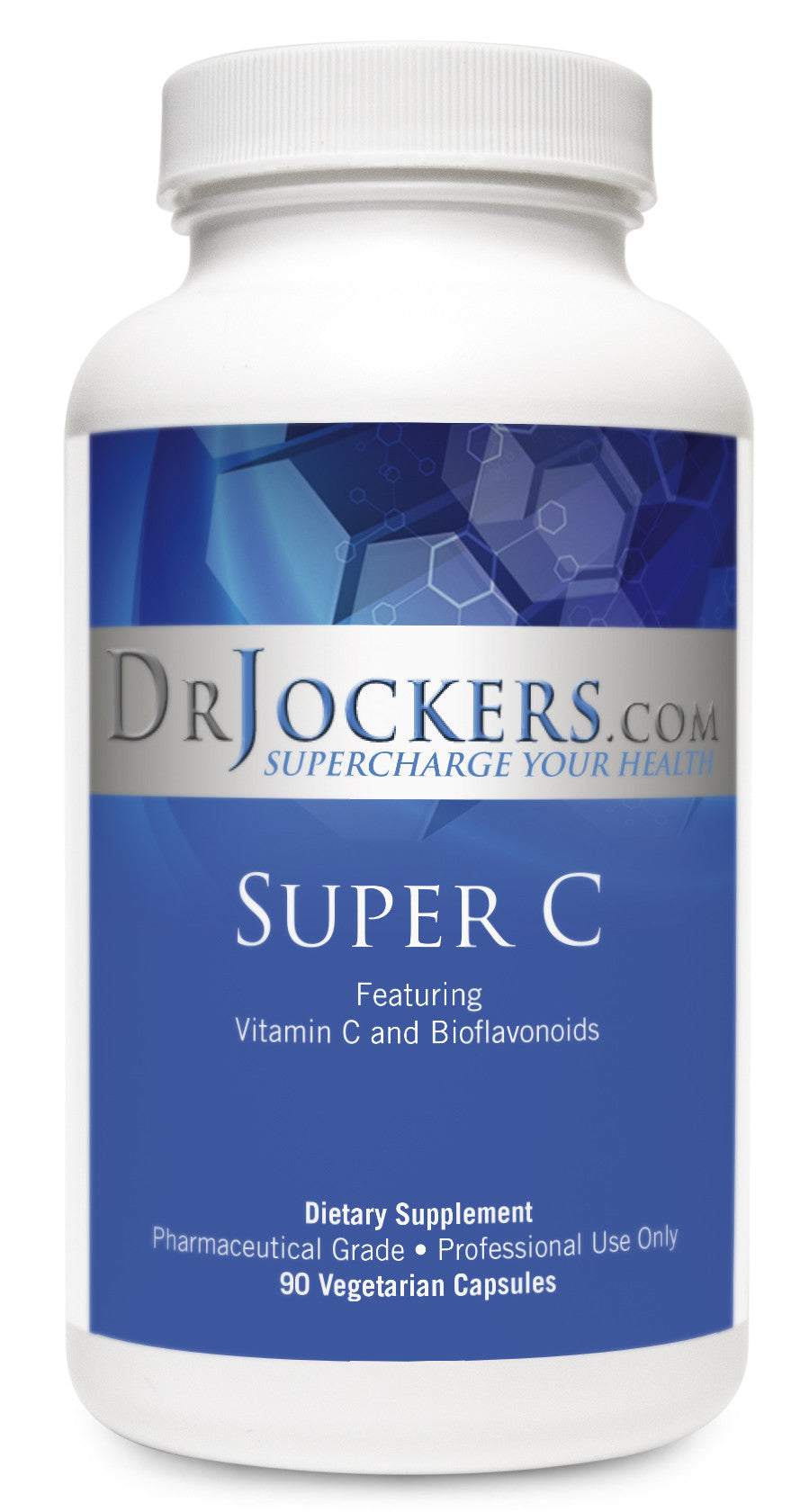
The combination of vitamin C and citrus bioflavonoids in Super C ensures that a wide range of metabolic functions will be supported.- Dr. Jockers
Let's discuss the key benefits of Super C:
Why are people taking Super C

I've been taking this for the past 6 months and because I have Epstein Barr, I know its important to take Vitamin C. This particular Vitamin C from Dr. Jockers helps my body compared to grocery store choices. I feel the difference. I take one every night. I highly recommend this supplement for anyone. - Elena
Read our customer reviews and you'll see why our clients agree these are...
Supplements You Can
TRUST
Super C

What is Vitamin C?
Vitamin C is one of the most widely recognized and used anti-oxidants in the world. This anti-oxidant plays a critical role in helping the immune system, joints, and arteries heal and function properly. The best way to use vitamin C is in combination with a natural bioflavinoid complex which synergizes with vitamin C to provide broad-spectrum anti-oxidant protection.
Much of our physiology is based on the movement of electrons from one compound to another. Unstable molecules that are missing an electron are called free radicals and they are catabolic to the body. These free radicals are formed in a cycle called oxidative stress that creates damage and instability in cells, tissues, and organs in the body. Vitamin C is an antioxidant that acts to donate an electron to neutralize free radicals and restore peace and harmony to the body.
What does Vitamin C do in our body?
Vitamin C has one of the most critical functions in the health of immune cells. White blood cells have to withstand the attack of various pathogens and free radicals and depend upon the anti-oxidant power of vitamin C to do so. Vitamin C also aids in reducing histamine-mediated inflammation associated with colds, fevers, flu, and allergies (1, 2, 3).
Vitamin C is also critical for healthy collagen formation within the body. Collagen production is important for to healthy skin, hair, ligaments, bones, tendons, and discs (4, 5). Using high doses of vitamin C has been shown in previous studies to improve the healing process of cuts, wounds, burns, sprains/strains, and broken bones (6, 7, 8).
Vitamin C plays such an important role in eye health that many experts believe taking 1-2 grams of supplemental vitamin C daily has the potential to stop cataracts altogether.
Why choose Vitamin C Supplementation?
In early 1972, a randomized, double-blind, placebo-controlled study of 1000 subjects taking 1000 mg of vitamin C per day provided support for the use of vitamin C supplementation for common immune challenges.
The study results revealed that the supplementation group missed significantly fewer days from work/activities and had fewer days per episode of immune challenge; in addition, significantly more subjects taking vitamin C remained symptom-free throughout the study (9)
What are Bioflavonoids?
Bioflavonoids (also known as flavonoids) are phytochemicals that are often found together with vitamin C in nature and are generally considered to be among the most important and interesting classes of biologically active compounds in contemporary research.
More than 4000 bioflavonoids have been identified. Intake of flavonoids is associated with healthy cardiovascular status, the body’s normal response to inflammation, and positive microbial balance (10, 11).
Citrus bioflavonoids are commonly used in Europe for blood vessel and lymph system support. US practitioners utilize bioflavonoids in protocols to support tissue and joint comfort and the body’s normal response to inflammation,(12-14) respiratory (15,16), eye health, and maintenance of cardiovascular health. (17-20)
Citrus bioflavonoids can cross the blood-brain barrier and have been recognized for their neuroprotective effects (21). As cell-signaling agents, bioflavonoids are believed to support healthy cell growth and normal cell-life regulation, stimulate detoxification enzymes, decrease vascular cell adhesion molecules, increase vasodilation, and support healthy platelet function (22).
Why choose Super C?
Super C™ combines high-potency vitamin C with a standardized, full-spectrum, citrus bioflavonoid complex. Both vitamin C and bioflavonoids have been extensively researched for their roles in supporting antioxidant and immune function.
Super C is formulated to provide antioxidant protection, enhance immune function, and support the synthesis and function of collagen, carnitine, and neurotransmitters. Each capsule of Super C provides 500 mg of vitamin C and 500 mg of citrus bioflavonoid complex in a one-to-one ratio.

*These statements have not been evaluated by the Food and Drug Administration. This product is not intended to diagnose, treat, cure, or prevent any disease. Rev. 09/22/15 References
What is the recommended dosage?
Normal Dosage: 1 capsule – 3x daily
Advanced Dosage: 2 capsules – 3x daily
When introducing a new supplement, we recommend taking the lowest dose for 2-3 days. As tolerated, increase the dose until you have reached the recommended normal or advanced guidelines. Reduce to a tolerable dosage if adverse effects occur.
- Shaik-Dasthagirisaheb YB, Varvara G, Murmura G, Saggini A, Caraffa A, Antinolfi P, Tete’ S, Tripodi D, Conti F, Cianchetti E, Toniato E, Rosati M, Speranza L, Pantalone A, Saggini R, Tei M, Speziali A, Conti P, Theoharides TC, Pandolfi F. Role of vitamins D, E and C in immunity and inflammation. J Biol Regul Homeost Agents. 2013 Apr-Jun;27(2):291-5. PMID: 23830380
- Banerjee D, Kaul D. Combined inhalational and oral supplementation of ascorbic acid may prevent influenza pandemic emergency: a hypothesis. Nutrition. 2010 Jan;26(1):128-32. PMID: 20005468
- Conway FJ, Talwar D, McMillan DC. The relationship between acute changes in the systemic inflammatory response and plasma ascorbic acid, alpha-tocopherol and lipid peroxidation after elective hip arthroplasty. Clin Nutr. 2014 Jul 10. PMID:25048713
- Kim B, Choi KM, Yim HS, Lee MG. Ascorbic acid enhances adipogenesis of 3T3-L1 murine preadipocyte through differential expression of collagens. Lipids Health Dis. 2013 Dec 11;12:182. PMID: 24325571
- Ahmad M, Ansari MN, Alam A, Khan TH. Oral dose of citrus peel extracts promotes wound repair in diabetic rats. Pak J Biol Sci. 2013 Oct 15;16(20):1086-94. PMID: 24506007
- Lam PL, Kok SH, Bian ZX, Lam KH, Gambari R, Lee KK, Chui CH. Microencapsulation-protected l-ascorbic acid for the application of human epithelial HaCaT cell proliferation. J Microencapsul. 2014;31(8):754-8. PMID: 24963963
- Sangani R, Naime M, Zakhary I, Ahmad S, Chutkan N, Zhu A, Ha Y, Hamrick M, Isales C, Elsalanty M, Smith S, Liou GI, Fulzele S. Regulation of vitamin C transporter in the type 1 diabetic mouse bone and bone marrow. Exp Mol Pathol. 2013 Dec;95(3):298-306. PMID: 23999113
- Allampallam K, Chakraborty J, Robinson J. Effect of ascorbic acid and growth factors on collagen metabolism of flexor retinaculum cells from individuals with and without carpal tunnel syndrome. J Occup Environ Med. 2000 Mar;42(3):251-9. PMID: 10738704
- Anderson TW, Reid DB, Beaton GH. Vitamin C and the common cold: a double-blind trial. Can Med Assoc J. 1972 Sep 23;107(6):503-8. [PMID: 5057006]
- Tripoli E, La Guardia M, Giammanco S, et al. Citrus flavonoids: Molecular structure, biological activity and nutritional properties: A review. Food Chemistry. 2007; 104(2):466- 79.
- Middleton E Jr, Kandaswami C, Theoharides TC. The effects of plant flavonoids on mammalian cells: implications for inflammation, heart disease, and cancer. Pharmacol Rev. 2000 Dec;52(4):673-751. Review. [PMID: 11121513]
- Guardia T, Rotelli AE, Juarez AO, et al. Anti-inflammatory properties of plant flavonoids. Effects of rutin, quercetin and hesperidin on adjuvant arthritis in rats. Farmaco. 2001 Sep;56(9):683-7. [PMID: 11680812]
- Rotelli AE, Guardia T, Juárez AO, et al. Comparative study of flavonoids in experimental models of inflammation. Pharmacol Res. 2003 Dec;48(6):601-6. [PMID: 14527825]
- Lin N, Sato T, Takayama Y,et al. Novel anti-inflammatory actions of nobiletin, a citrus polymethoxy flavonoid, on human synovial fibroblasts and mouse macrophages. Biochem Pharmacol. 2003 Jun 15;65(12):2065-71. [PMID: 12787887]
- Pijnenburg MW, Hofhuis W, Hop WC, et al. Exhaled nitric oxide predicts asthma relapse in children with clinical asthma remission. Thorax. 2005 Mar; 60(3):215-8. [PMID: 15741438]
- Lee NK, Choi SH, Park SH, et al. Antiallergic activity of hesperidin is activated by intestinal microflora. Pharmacology. 2004 Aug;71(4):174-80. [PMID: 15240993]
- Majumdar S, Srirangam R. Potential of the bioflavonoids in the prevention/treatment of ocular disorders. J Pharm Pharmacol. 2010 Aug;62(8):951-65. Review. [PMID: 20663029]
- Wright B, Spencer JP, Lovegrove JA, et al. Insights into dietary flavonoids as molecular templates for the design of anti-platelet drugs. Cardiovasc Res. 2012 Nov 1. [Epub ahead of print] [PMID: 23024269]
- Mulvihill EE, Huff MW. Citrus flavonoids and the prevention of atherosclerosis. Cardiovasc Hematol Disord Drug Targets. 2012 Oct 1. [Epub ahead of print] [PMID: 23030447]
- Soory M. Nutritional antioxidants and their applications in cardiometabolic diseases. Infect Disord Drug Targets. 2012 Nov 16. [Epub ahead of print] [PMID: 23167714]
- Hwang SL, Shih PH, Yen GC. Neuroprotective effects of citrus flavonoids. J Agric Food Chem. 2012 Feb 1;60(4):877-85. doi: 10.1021/jf204452y. Epub 2012 Jan 23. Review. [PMID: 22224368]
- Linus Pauling Institute. Micronutrient Information Center. Flavonoids. http://lpi.oregonstate. edu/infocenter/phytochemicals/flavonoids/. Updated June 2008. Accessed December 10, 2012. Additional references available upon request
Select Your Options & Add to Cart
† These statements have not been evaluated by the Food and Drug Administration.
This product is not intended to diagnose, treat, cure or prevent any disease.








